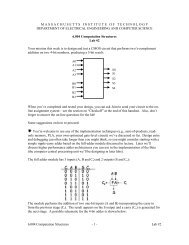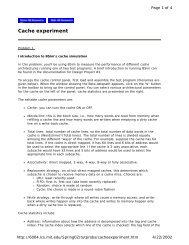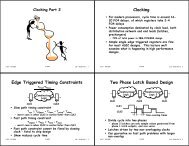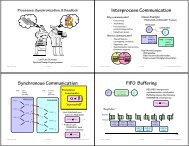PDF w/o answers - 6.004 - MIT
PDF w/o answers - 6.004 - MIT
PDF w/o answers - 6.004 - MIT
You also want an ePaper? Increase the reach of your titles
YUMPU automatically turns print PDFs into web optimized ePapers that Google loves.
Tischtennis-Bezirksverband Braunschweig e.V.Bezirksoberliga Nord HerrenStaffelleiter: Lothar Fricke, Im Grasgarten 4, 31246 LahstedtTel.: 0 51 72/45 34, FAX 0 51 72/41 05 21, Email: Lothar.Fricke@t-online.de, Internet: http://www.fricke.ttvn.deSpieljahr 2006/07 – 8. RundschreibenLiebe Sportfreunde,anliegend erhaltet ihr ein weiteres Rundschreiben zum Spieljahr 2006/07 mit aktuellen Informationen zumSpielbetrieb.Spielplan und ErgebnismeldungenÜberprüft bitte den Spielplan umgehend mit Euren Aufzeichnungen. Eventuelle Fehler sind mir sofortmitzuteilen. Ansonsten ist der Spielplan hinsichtlich Ort, Termin, und Zeit verbindlich.Für alle Mannschaften ist die Ergebniseingabe ab Spieljahr 2005/06 wie folgt geregelt:ErgebnisdienstEingabeder Mannschaftsergebnisse→ Online→ SMSEingabeder Spielberichte→ OnlineWann ? Wann ?unmittelbar nach SpielendeWochenendspiele (Fr. bis So.)spätestens Montag 13:00 UhrWochentagsspielespätestens 24 Stunden nach SpielbeginnSpielberichtsformularesind mir per FAX (0 51 72/41 05 21) zu übermitteln,spätestens am Tag nach dem Spiel an mich zu senden.Die Originalspielberichtsformulare sind bis zum Spieljahresende aufzubewahren.MannschaftsaufstellungenDie beigefügten Mannschaftsaufstellungen sind verbindlich.Bei MTV Hattorf III hat es noch eine Änderung gegeben:Holtermann, Martin => II/6Bader, Artur=> III/1MannschaftsmeldungIn click-TT sind die erforderlichen Umstellungen von den Vereinen fristgerecht vorgenommen und von mirgenehmigt worden.Bei allen Punktspielen ist die genehmigte Mannschaftsmeldung unaufgefordert dem gegnerischenMannschaftsführer vorzulegen und von diesem zu kontrollieren.Zu diesem Zweck lasst euch von eurem Vereinsadministrator vor dem ersten Punktspiel AnfangJanuar 2007 im Downloadbereich eures Vereins in „click-TT“ die aktuelle Mannschaftsmeldungausdrucken.Tischtennis-Bezirksverband Braunschweig e.V. – Bezirksoberliga Nord HerrenSpieljahr 2006/07 – 8. RundschreibenSeite 1 von 2 // hbol06-8.doc
http://xtutor.csail.mit.edu/<strong>6.004</strong>/currentsemester/tutprobs/info.htmPage 2 of 82/5/2004Using Tree #1, decode the following encoded message: "01000111101".C. Suppose we were encoding messages that have the following probabilities foreach of the 5 symbols:p(A) = 0.5p(B) = p(C) = p(D) = p(E) = 0.125Which of the two encodings above (Tree #1 or Tree #2) would yield the shortestencoded messages averaged over many messages?D. Using the probabilities for A, B, C, D and E given above, construct a variablelengthbinary decoding tree using a simple greedy algorithm as follows:1. Begin with the set S of symbols to be encoded as binary strings, together withthe probability P(x) for each symbol x. The probabilities sum to 1, and measurethe frequencies with which each symbol appears in the input stream. In theabove example, the initial set S contains the five symbols and associatedprobabilities.2. Repeat the following steps until there is only 1 symbol left in S:A. Choose the two members of S having lowest probabilities. Choosearbitrarily to resolve ties. In the example above, D and E might be thefirst nodes chosen.B. Remove the selected symbols from S, and create a new node of thedecoding tree whose children (sub-nodes) are the symbols you'veremoved. Label the left branch with a "0", and the right branch with a"1". In the first iteration of the example above, the bottom-most internalnode (leading to D and E) would be created.C. Add to S a new symbol (e.g., "DE" in our example) that represents thisnew node. Assign this new symbol a probability equal to the sum of theprobabilities of the two nodes it replaces.E. Huffman coding is used to compactly encode the species of fish tagged by a gamewarden. If 50% of the fish are bass and the rest are evenly distributed among 15other species, how many bits would be used to encode the species of a bass?
http://xtutor.csail.mit.edu/<strong>6.004</strong>/currentsemester/tutprobs/info.htmPage 4 of 82/5/2004I p(I) = 0.15O p(O) = 0.15U p(U) = 0.15A. If you are told that the first letter of a message is "A", give an expression for thenumber of bits of information have you received.B. Ben is trying to invent a fixed-length binary encoding for DDS that permitsdetection and correction of single bit errors. Briefly describe the constraints on Ben'schoice of encodings for each letter that will ensure that single-bit error detection andcorrection is possible. (Hint: think about Hamming distance.)C. Giving up on error detection and correction, Ben turns his attention totransmitting DDS messages using as few bits as possible. Assume that each letterwill be separately encoded for transmission. Help him out by creating a variablelengthencoding that minimizes the average number of bits transmitted for eachletter of the message.Problem 4. Modular arithmetic and 2's complement representationMost computers choose a particular word length (measured in bits) for representingintegers and provide hardware that performs various arithmetic operations on word-sizeoperands. The current generation of processors have word lengths of 32 bits; restrictingthe size of the operands and the result to a single word means that the arithmeticoperations are actually performing arithmetic modulo 2 32 .Almost all computers use a 2's complement representation for integers since the 2'scomplement addition operation is the same for both positive and negative numbers. In 2'scomplement notation, one negates a number by forming the 1's complement (i.e., for eachbit, changing a 0 to 1 and vice versa) representation of the number and then adding 1. Byconvention, we write 2's complement integers with the most-significant bit (MSB) on theleft and the least-significant bit (LSB) on the right. Also by convention, if the MSB is 1, thenumber is negative; otherwise it's non-negative.A. How many different values can be encoded in a 32-bit word?B. Please use a 32-bit 2's complement representation to answer the following questions.What are the representations forzerothe most positive integer that can be represented
http://xtutor.csail.mit.edu/<strong>6.004</strong>/currentsemester/tutprobs/info.htmPage 5 of 82/5/2004the most negative integer that can be representedWhat are the decimal values for the most positive and most negative integers?C. Since writing a string of 32 bits gets tedious, it's often convenient to use hexadecimalnotation where a single digit in the range 0-9 or A-F is used to represent groups of 4bits using the following encoding:hex bits hex bits hex bits hex bits0 0000 4 0100 8 1000 C 11001 0001 5 0101 9 1001 D 11012 0010 6 0110 A 1010 E 11103 0011 7 0111 B 1011 F 1111Give the 8-digit hexadecimal equivalent of the following decimal and binary numbers:37 10 , -32768 10 , 11011110101011011011111011101111 2 .D. Calculate the following using 6-bit 2's complement arithmetic (which is just afancy way of saying to do ordinary addition in base 2 keeping only 6 bits of youranswer). Show your work using binary (base 2) notation. Remember that subtractioncan be performed by negating the second operand and then adding it to the firstoperand.13 + 1015 - 1827 - 6-6 - 1521 + (-21)31 + 12Explain what happened in the last addition and in what sense your answer is "right".E. At first blush "Complement and add 1" doesn't seem an obvious way to negate atwo's complement number. By manipulating the expression A+(-A)=0, show that"complement and add 1" does produce the correct representation for the negative ofa two's complement number. Hint: express 0 as (-1+1) and rearrange terms to get -A on one side and XXX+1 on the other and then think about how the expression XXXis related to A using only logical operations (AND, OR, NOT).Problem 5. Error detection and correctionA. To protect stored or transmitted information one can add check bits to the data tofacilitate error detection and correction. One scheme for detecting single-bit errors isto add a parity bit:
http://xtutor.csail.mit.edu/<strong>6.004</strong>/currentsemester/tutprobs/info.htmPage 6 of 82/5/2004b 0 b 1 b 2 b N-1 pWhen using even parity, p is chosen so that the number of "1" bits in the protectedfield (including the p bit itself) is even; when using odd parity, p is chosen so that thenumber of "1" bits is odd. In the remainder of this problem assume that even parityis used.To check parity-protected information to see if an error has occurred, simplycompute the parity of information (including the parity bit) and see if the result iscorrect. For example, if even parity was used to compute the parity bit, you wouldcheck if the number of "1" bits was even.If an error changes one of the bits in the parity-protected information (including theparity bit itself), the parity will be wrong, i.e., the number of "1" bits will be oddinstead of even. Which of the following parity-protected bit strings has a detectableerror?(1) 11101101111011011(2) 11011110101011011(3) 10111110111011110(4) 00000000000000000B. Detecting errors is useful, but it would also be nice to correct them! To build an errorcorrecting code (ECC) we'll use additional check bits to help pinpoint where the erroroccurred. There are many such codes; a particularly simple one for detecting andcorrecting single-bit errors arranges the data into rows and columns and then adds(even) parity bits for each row and column. The following arrangement protects ninedata bits:b0,0 b0,1 b0,2 prow0b1,0 b1,1 b1,2 prow1b2,0 b2,1 b2,2 prow2pcol0 pcol1 pcol2A single-bit error in one of the data bits (b I,J ) will generate two parity errors, one inrow I and one in column J. A single-bit error in one of the parity bits will generatejust a single parity error for the corresponding row or column. So after computing theparity of each row and column, if both a row and a column parity error are detected,inverting the listed value for the appropriate data bit will produce the corrected data.If only a single parity error is detected, the data is correct (the error was one of theparity bits).Give the correct data for each of the following data blocks protected with therow/column ECC shown above.(1) 1011 (2) 1100 (3) 000 (4) 01110110 0000 111 10010011 0101 10 0110011 100 100
http://xtutor.csail.mit.edu/<strong>6.004</strong>/currentsemester/tutprobs/info.htmPage 7 of 82/5/2004C. The row/column ECC can also detect many double-bit errors (i.e., two of the data orcheck bits have been changed). Characterize the sort of double-bit errors the codedoes not detect.D. In the days of punch cards, decimal digits were represented with a special encodingcalled 2-out-of-5 code. As the name implies two out of five positions were filled with1's as shown in the table below:Code Decimal11000 110100 201100 310010 401010 500110 610001 701001 800101 900011 0What is the smallest Hamming distance between any two encodings in 2-out-of-5code?E. Characterize the types of errors (eg, 1- and 2-bit errors) that can be reliablydetected in a 2-out-of-5 code?F. We know that even parity is another scheme for detecting errors. If we change froma 2-out-of-5 code to a 5-bit code that includes an even parity bit, how manyadditional data encodings become available?Problem 6. Hamming single-error-correcting-codeThe Hamming single-error-correcting code requires approximately log2(N) check bits tocorrect single-bit errors. Start by renumbering the data values with indices that aren'tpowers of two:
http://xtutor.csail.mit.edu/<strong>6.004</strong>/currentsemester/tutprobs/info.htmPage 8 of 82/5/2004Indices for 16 data values = 3, 5, 6, 7, 9, 10, 11, 12, 13, 14, 15, 17, 18, 19, 20, 21The idea is to compute the check bits choosing subsets of the data in such a way that asingle-bit error will produce a set of parity errors that uniquely indicate the index of thefaulty bit:p0 = even parity for data bits 3, 5, 7, 9, 11, 13, 15, 17, 19, 21p1 = even parity for data bits 3, 6, 7, 10, 11, 14, 15, 18, 19p2 = even parity for data bits 5, 6, 7, 12, 13, 14, 15, 20, 21p3 = even parity for data bits 9, 10, 11, 12, 13, 14, 15p4 = even parity for data bits 17, 18, 19, 20, 21Note that each data bit appears in at least two of the parity calculations, so a single-biterror in a data bit will produce at least two parity errors. When checking a protected datafield, if the number of parity errors is zero or one, the data bits are okay (exactly oneparity error indicates that one of the parity bits was corrupted). If two or more parityerrors are detected then the errors identify exactly which bit was corrupted.A. What is the relationship between the index of a particular data bit and the checksubsets in which it appears? Hint: consider the binary representation of the index.B. If the parity calculations involving p0, p2 and p3 fail, assuming a single-bit errorwhat is the index of the faulty data bit?C. The Hamming SECC doesn't detect all double-bit errors. Characterize the types ofdouble-bit errors that will not be detected. Suggest a simple addition to the HammingSECC that allows detection of all double-bit errors.


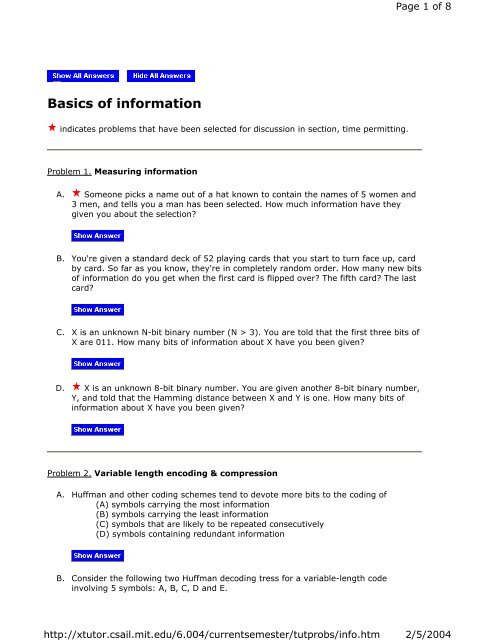
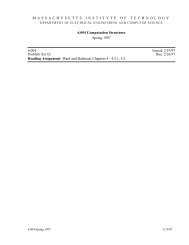
![Semaphores [Printable PDF version]](https://img.yumpu.com/51161588/1/190x245/semaphores-printable-pdf-version.jpg?quality=85)
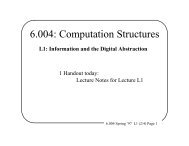
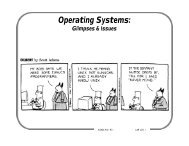

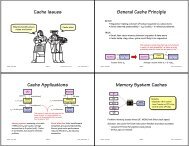


![Gates and Boolean logic [Printable PDF version] - MIT](https://img.yumpu.com/43807495/1/190x245/gates-and-boolean-logic-printable-pdf-version-mit.jpg?quality=85)
